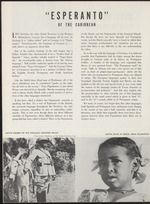| 1 |
 |
“...and a tree grows out of this
seed (a kind of pidgin-negro-portuguese) which all the
slaves who are transported on Portuguese ships, are obliged
to adopt. The European languages spoken in their new
homeland (Spanish, French, English and Dutch) are then
grafted on the old tree and sprout forth in new roots while
the essence of the language retains its Yucan character in
pronunciation and gratnmar.” And this may explain why
the pronunciation so often reminds one of that language,
especially in the nasal sound which is given to final “n”,
and in the “si”—sound, which is of Portuguese origin.
We must, of course, not forget that, like other languages,
both Spanish and Portuguese have undergone some changes
in the course of two and a half centuries, and that it is,
therefore, very likely that originally there were fewer diver-
gencies between them and Papiamento than there are in
modern times.
NATIVE CHILD AT ZESOE, NEAR WILLEMSTAD...”
|
|
